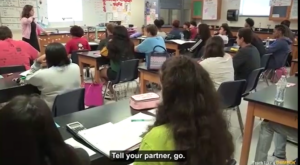09.04.24Step One for a Productive and Positive Classroom: Strong Procedures and Routines for Participation

The beginning of the year is the time to be installing strong procedures and routines in the classroom.
It’s one of the most important things you can do to set yourself up for a productive and positive year of learning.
When there’s a right way to do a task and it’s familiar to the point of habit, it “hacks working memory”- that is, it allows students to complete the task with working memory focused exclusively on the content and not the details of the task.
Further familiar procedures oddly build a sense of belonging. Every faith sings or worships in unison. When we all do something the same it signals that we are parts of a greater whole.
Consider Turn and Talk. In this short clip, Sadie McCleary asks her students to discuss the characteristics of a gas and the room crackles to life. Students are thinking about elasticity and temperature, not: “Wait who am I talking to?” “Will they really want to talk about chemistry with me?” and “What will happen afterwards?”
And of all the procedure and routines in an effective classroom the most important are for the things students do most frequently and that most effect learning. And the most common thing students do that most effects their learning is: answer the teacher’s questions.
If there’s a strong procedure for Turn and Talk and everyone knows it cold, then learning and thinking can be maximized and–as Sadie does here–a sense of “flow” can often be created in the classroom–students are busy and active throughout and more likely to lose themselves in the content.
In fact you’ll notice that there is more than one familiar-procedure-for-answering-questions-made-a-habit in Sadie’s classroom. In addition to Turn and Talk, Sadie uses Cold Call as well. Students give strong answers in part because they use the Turn and Talks optimally; they know they might be accountable to discuss their thinking afterwards. This part too is predictable.
There are in fact a relatively finite number of productive ways that students can answer a question in class… perhaps five:
- They can raise their hands
- They can respond when the teacher cold calls them.
- They can answer by turning and talking briefly with a classmate
- They can write their answer briefly in a notebook say or on a white board
- They can answer chorally
When we write or present about this idea my colleagues and I call it Means of Participation:
- How you answer the question is as important as the question itself.
- Intentionally design the process for how students will do each of these.
- Use them frequently and consistently right away so they become routine.
- Cue students clearly so they know which routine you are using.
- Then students can participate optimally and you can ensure deep and broad participation among your class like Sadie does.
And as we will see in part 2, designing and building these routines responds to preparation and practice….
